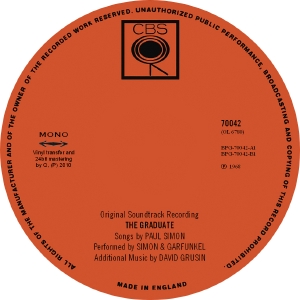

Original Soundtrack - The Graduate
UK CBS Mono LP, (M) 70042
First released January 1968
01 - Sounds Of Silence
02 - The Singleman Party Foxtrot
03 - Mrs. Robinson
04 - Sunporch Cha-Cha-Cha
05 - Scarborough Fair-Canticle (Interlude)
06 - On The Strip
07 - April Come She Will
08 - The Folks
09 - Scarborough Fair-Canticle
10 - A Great Effect
11 - The Big Bright Green Pleasure Machine
12 - Whew
13 - Mrs. Robinson
14 - Sounds Of Silence
==About the album==
Review by Bruce Eder for allmusic.com...
The soundtrack to Mike Nichols' The Graduate remains a key musical document of the late '60s, although truth be told, its impact was much less artistic than commercial (and, for that matter, more negative than positive). With the exception of its centerpiece track, the elegiac and oft-quoted "Mrs. Robinson" -- which only appears here as a pair of fragments -- the Simon & Garfunkel songs that comprise much of the record (a series of Dave Grusin instrumentals round it out) appeared on the duo's two preceding LPs; Nichols' masterstroke was to transplant those songs into his film, where they not only meshed perfectly with the story's themes of youthful rebellion and alienation (and the inner life of the central character, Dustin Hoffman's Benjamin Braddock) but also heralded a new era in movie music centered around the appropriation of past pop hits, a marketing gimmick that grew exponentially in the years to follow. The Graduate soundtrack, then, merits the dubious honor of being the earliest and one of the most successful Hollywood repackagings of "found" pop songs, a formula essentially based around coercing fans to purchase soundtrack albums filled with material they already own in order to acquire the occasional new track or two.
The album began its life because of Nichols' enthusiasm for the duo's music, and Columbia Records chief Clive Davis' ability to persuade the pair of the importance of a soundtrack LP. Davis turned the actual making of the album over to producer Teo Macero, who approached it with skepticism -- Paul Simon and Mike Nichols had discovered that they really weren't on the same page, with Nichols rejecting "Overs" and "Punky's Dilemma," songs that ended up as highlights of the Bookends album, issued two months after The Graduate soundtrack. Thus, there wasn't enough Simon & Garfunkel material to fill even one LP side, and only about eight minutes of that were "new" recordings, and barely a quarter of that (the "Mrs. Robinson" fragments) new song material. And there also wasn't enough of David Grusin's instrumental music (none of which meshed with the duo's work) for an album. Macero combined this material into a musically awkward LP that somehow did its job -- which, in Davis' eyes, was to introduce Simon & Garfunkel's music to the parents of their existing audience (topping the charts in the bargain, and turning Grusin's "Sunporch Cha-Cha-Cha" into a favorite of easy listening stations). Fans of Simon & Garfunkel likely felt cheated by the presence of the "Mrs. Robinson" fragments, as well as repeats of the 1966-vintage "The Sound of Silence" and "April Come She Will," and an edited extension of "Scarborough Fair/Canticle." But there were two curiosities for the completist -- a high-wattage, edited rendition of "The Big Bright Green Pleasure Machine" (in a style seemingly parodying the sound of Bob Dylan's Highway 61 Revisited); and a gentle, subdued acoustic reprise of "The Sound of Silence," which was possibly the best studio rendition the duo ever gave of the song.
==About this transfer==
The UK mono LP appears to be a folddown of the stereo LP (so, too, apparently, is the US mono LP). So why did I transfer it? Because I found that Dave Grusin's numbers in particular sounded much stronger in mono than in stereo (and more befitting the style), to the point where I'm not convinced that the Grusin tracks, at least, are folddowns.
As always, you might occasionally hear what sounds like vinyl clicks or noise on some of the tracks. Such noise is not from the vinyl. As many listeners will know, raw acoustic recordings can sound quite "dirty", with clicks and other noises captured on the master tape from guitar fretboards, breath intakes and just general background noise from recording limitations of the time. For removing clicks and the like I used an original stereo CD as reference. If the noise existed on the reference copy (and that includes the pulsating hum lightly audible in the quiet parts and fade outs), it stayed on my transfer as a faithful reproduction of the original master tape and of the exact sound that you heard all those years ago.
==Vinyl transfer and 24bit mastering by Q==
Source Matrices
01-08: BPG-70042-A1
09-14: BPG-70042-B1
Hardware
- Project Xpression III Turntable
- Ortofon 2M Blue Cartridge
- Project SpeedBox II Quartz-Generated Electronic Speed Regulator
- Denon PMA-700AE Integrated Amplifier
Software
- Audition 3.0.1 (audio capture and editing)
- iZotope RX 2 Advanced (resampling and dithering to Red Book audio specifications)
Artwork included